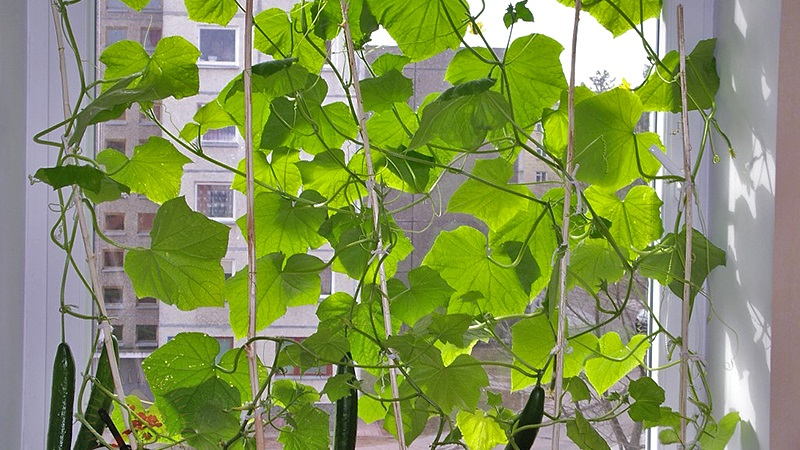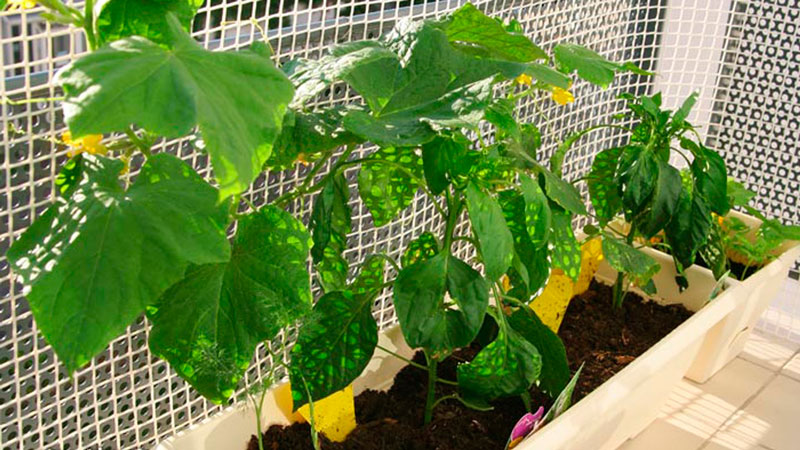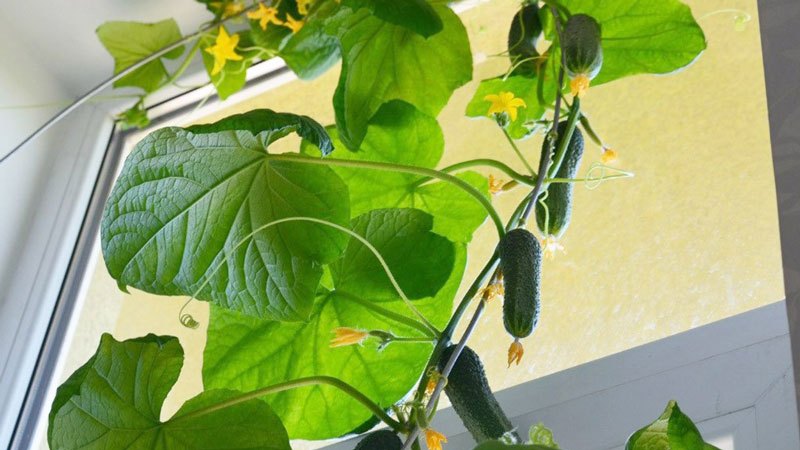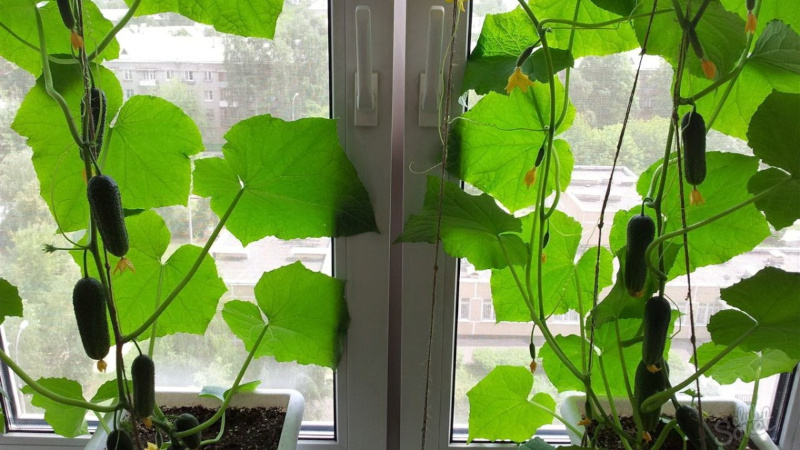How to grow cucumbers on the windowsill in winter
Not everyone has a garden or summer cottage, but everyone wants to have tasty and healthy eco-vegetables on the table. It is not difficult to make this dream a reality if you cultivate vegetables in an apartment on the windowsill, especially if the windows face the sunny side.
Growing plants is an interesting business, and in the case of cucumbers, it is also useful. You will learn how to grow cucumbers on a windowsill in winter from the article.
The content of the article
Features of growing cucumbers on the windowsill
Cucumbers are grown on a light and spacious windowsill. To give the plant more light, a mirror is installed next to the bush or reflective foil is attached. To prevent hypothermia of the bush, an insulating material is placed under the pot, for example, a sheet of foam.

Optimal sowing time
Fruiting of cucumbers begins 40-50 days after germination. The duration of fruiting is 1-1.5 months, so one-time sowing is not enough. If you want to have fresh vegetables 4-6 months a year, you need to plant seeds 3-4 times.
Accordingly, the interval between crops will be 30-45 days. As soon as the first generation of cucumbers stops bearing fruit, the second will immediately begin to yield, and so on.
Which varieties are suitable for home cultivation
For planting and growing on the windowsill, early parthenocarpic hybrids are chosen, which are pollinated independently. Also, ordinary balcony varieties are suitable for these purposes, but when growing on a closed window, they will need help with pollination.
The selected hybrids or varieties should grow well in a lack of light. It is also important that the culture is not tall, otherwise the plant will take up a lot of space on the window.
For the cultivation of cucumbers all year round on the windowsill, the following varieties and hybrids are chosen: Athlete, Openwork, Balcony, City gherkin, Courage, Connie, Room miracle, Room, Our Masha, Real Colonel, Merenga, Premium, Prestige, Talisman, Chistye prudy, Miracle on window, Pharaoh.
Basic rules for growing
After choosing a variety and purchasing seeds, they prepare everything necessary for planting work. Together with the seed in the gardening store, a soil substrate is purchased. If there is no suitable container at home, they buy it too.

Choosing a container for growing
For growing seedlings, plastic containers, wooden boxes, peat cups or tablets, milk or juice boxes are used. Before use, the containers are thoroughly washed with laundry soap and poured over with boiling water.
Peat products are placed in a common container and filled with warm water to swell. When they increase several times in size, they land.
Preparing the soil
For growing cucumbers, a commercially available universal soil or substrate for pumpkin crops is perfect. The soil purchased from the store goes through all the necessary processing during production, but some vegetable growers prepare the substrate on their own from the following components:
- Humus and peat are mixed in equal proportions. Add 1 tbsp to the bucket of the mixture. wood ash.
- Mix one part of the sod, compost and garden soil. A small amount of river sand, rotted sawdust and ash are added to the resulting composition.
Next, the prepared soil is disinfected: calcined in the oven, doused with boiling water and a weak solution of potassium permanganate. Such activities destroy microbes and pest larvae. Disinfection is performed a few days before sowing, so that beneficial soil bacteria are restored during this time.
Seed preparation
Growing cucumbers on a window in winter will be easy if the seed is properly processed. The seeds are calibrated first. In a glass of water, dilute 1 tsp. soda and grains are placed in it for 20 minutes. The floating seeds are not suitable for planting - they are dummies. The remaining seeds are removed and dried.
Then the grains are kept for 20-30 minutes in a weak solution of potassium permanganate and washed under running water. The next stage is seed germination. The seeds are wrapped in a damp cotton cloth and placed on a saucer. The seeds are kept in this state until seed-sized sprouts appear. The fabric is periodically moistened.
Landing
The seeds are planted in rows at a distance of 2-3 cm from each other, and the grains are deepened by 1 cm.If they are planted in separate containers, then two seeds are embedded in the soil for safety reasons. In the future, the weaker sprout is removed.
The soil is moistened from a spray bottle and the container is covered with film or transparent glass to create a greenhouse environment. Seedlings are exposed to the lightest place and kept at room temperature until shoots appear. Then the shelter is removed.
Transplanting cucumbers to a permanent place
The optimal age of plants for transplanting to a permanent place is when they form 2-3 true leaves and a compact, unstretched stem. Such seedlings are more likely to take root in a new location.
Care features

To safely grow cucumbers in the winter at home on the window, adhere to agrotechnical rules. This process may seem boring to novice vegetable growers, but the culture will delight you with delicious and high-quality vegetables.
Watering
Plants are moistened with standing water at room temperature... If a to water cold from the tap, the seedlings are supercooled, the roots die off. The amount of soil in the pots is small, so the soil dries quickly. Cucumber culture is demanding on moisture, so the soil is not allowed to dry out.
Plants are watered moderately at the root in the morning. In the evening, they do not do this, because at night condensation will collect on the foliage. Excess moisture at night becomes the cause of fungal diseases.
Temperature regime
The optimum air temperature for cultivating cucumbers on a window is from + 18-26 ° С. This indicator should not change. If this is required, window frames are insulated, since cucumbers on the windowsill do not tolerate drafts in winter. The cold from the window can kill the plant or slow down the ripening of fruits even in a warm room.
Correct lighting
For full growth, the plant needs at least 12-14 hours of lighting per day. Therefore, in winter, when the daylight hours are short, lamps are used for additional illumination. They are installed at a distance of 30-40 cm from the tops of the plants.
Accordingly, as the bushes grow, the lamps are raised. To provide the maximum amount of light, reflective foil is attached above the lamp or on the sides of the plants.
Fertilization and dressing

The first fertilization is carried out during the formation of the second true leaf. The entire growing season culture feed every 7-10 days. To do this, use:
- wood ash;
- complex fertilizers;
- humates.
An infusion is prepared from ash (100 g per 1 liter of water), it is also lightly sprinkled with soil surface... During the flowering period, foliage and stems are sprayed with a boric mixture (2 g of boric acid per 2 L of water).
They also insist banana peels in water. Plants are watered with this solution during fruiting. Liquid preparations for fertilizing cucumbers:
- "Good power" for cucumbers;
- "Zdraven";
- Florhumat;
- ROST.
pinching and shaping a bush
Depending on the variety, the bushes are formed in different ways. A strong-growing plant is led into one stem. Stepsons that appear in the sinuses are removed. Weak cucumbers are grown in 1-2 stems.
Growing weakly braided varieties in two stems:
- the main shoot is pinched over the fourth leaf;
- two second-order shoots are left;
- lashes are tied to supports.
Important! The main thing is to blind the ovaries in the first and second sinuses in time, as they slow down the ripening of cucumbers.
Tying

Without a garter, plants are poorly ventilated and shade each other. The whips are tied up with a nylon cord to a vertical support, which is located in a pot.
A trellis is also installed. To do this, a metal ring is screwed to the slope, to which a rope is tied. Its second end is fixed on a wooden peg, which is installed in a pot. As the culture grows, the lashes are tied or attached to the cord with special plastic clips.
For your information. Some growers fix a plastic mesh in the window opening. Varieties with antennae themselves cling to the cells, whiskerless plants are tied up on their own.
Pollination
Artificial pollination is required for bee-pollinated cucumber varieties. The event is held in the morning. The male flower is plucked, the petals are folded back and touched by its central part to the stamens of the female open buds.
Harvesting rules
In winter, only early varieties of cucumbers are grown on the windowsill. They begin bearing fruit approximately 40-50 days after germination. At this time, the plants are still weak, so the first fruits that have set are plucked at the ovary stage.
The culture suffers the first fruiting with difficulty. A plant that is not yet fully formed gives all its strength to cucumbers, which inhibits its growth and further development. Thus, the lashes are allowed to grow stronger, which allows the culture to produce a much larger yield in the future than in the case of growing the firstborn to full size.
Vegetables are harvested every 2-3 days. If the crop is not harvested on time, the growth of further ovaries and the formation of new cucumbers will significantly slow down. One overripe vegetable in winter stops the growth of the entire lash. If this is allowed, the plant on the windowsill in winter may stop developing altogether.
Possible problems

The most common difficulties in home cultivation are:
- If the vegetables are bitter, this means that there is an excess of cucurbitacin in the fruits, which occurs when unfavorable growing factors: sudden temperature changes, severe cold snap or, conversely, heat, lack of watering.
- If the lower leaves dry, this is due to too high temperature and low humidity in the room.
- If the lower leaves of the seedlings turn yellow, top dressing is applied containing potassium, phosphorus and magnesium.
- If the seedlings are stretched out, then the culture does not have enough light and you need to add a little potting soil. It is poured 2-3 times a month.
Important! They buy those varieties of cucumbers that have the inscription "genetically without bitterness" on the packaging. These vegetables will never taste bitter.
Is it possible to face diseases and pests when growing at home
Cucumbers growing on the windowsill are most often affected by aphids and indoor midges (mushroom mosquitoes). Aphids can be brought home with flowers. The pest is disposed of by washing the leaves with soapy water. The procedure is carried out once a week. Midges and larvae are more likely to start in October and March. The roots suffer from the larvae in the ground. They are destroyed with insecticidal preparations, for example, "Aktara", "Mukhoed" or "Bazudin".
Of the diseases, the black leg threatens indoor cucumbers. This is a fungal disease that affects young plants. Reasons - poorly disinfected priming, poorly prepared seed material, low temperatures and waterlogging of the crop.
Terms of germination and harvesting
If the seeds were previously germinated, then the first shoots appear 3-5 days after sowing, and when planting dry seeds, the germination period increases to 5-7 days.
The duration of the ripening of the crop depends on the variety of cucumbers. Early ripening plants begin to bear fruit after 40-50 days.
Important! The fruits are harvested when their size reaches 8-10 cm. If the harvest is removed in time and not allowed to overgrow, new vegetables will immediately begin to form on the bush.
Conclusion
Growing cucumbers on the windowsill in winter is not difficult, and the harvest can be harvested all year round. To do this, create summer indoor weather for the culture. The choice of variety and preparation of seeds with soil should be approached correctly. You will also need lighting equipment. When the right conditions are created, the crop will delight you with the harvest, regardless of the season.